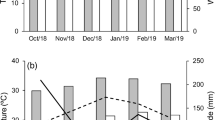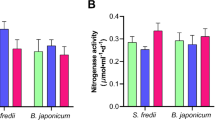Abstract
Soybean plants cv. Corsoy were grown in greenhouse conditions on sterilized quartz sand. They were inoculated with Bradyrhizobium japonicum, strain 542. The plants were treated with different concentrations of quercetin (ranging from 10 nM to 1μM) at regular intervals during the experiment. The experiment was terminated at flower development. The following parameters, important for symbiosis efficiency were determined: shoot, root and nodule weights, nodule number, total leghemoglobin in the nodules,total nitrogen and soluble protein concentrations in shoots and roots, as well as chlorophyll concentration in the leaves.
The results obtained partly confirmed the earlier findings that quercetin inhibits nodulation since increasing quercetin concentration decreased the number of nodules. However, at very low concentrations, quercetin stimulated the number of nodules. Quercetin also exerted a stimulating influence on other characteristics of the plant and nodules which did not correlate with nodule number and quantity of N fixed. These are: nodule weight, leghemoglobin concentration, total soluble protein content in shoots and roots as well as shoot and root weight.
Similar content being viewed by others
References
Fehr W R C, Cariness C E, Burmood D T and Pennington J S 1971 Stage of development description for soybean, Glycine max (L) Merill. Crop Sci. 11, 929–931.
Firmin J L, Wilson K E, Rossen L and Johnston A W B 1986 Flavonoid activation of nodulation genes in Rhizobium reversed by other compounds present in plants. Nature 324, 90–92.
Glass A D M 1973 Influence of phenolic acids on ion uptake. I. Inhibition of phosphate uptake. Plant Physiol. 51, 1037–1041.
Glass A D M 1974 Influence of phenolic acids on ion uptake. III. inhibition of potassium uptake. J. Exp. Bot. 25, 1104–1113.
Glass A D M and Dunlop J 1974 Influence of phenolic acids on ion uptake. IV. Depolarization of membrane potentials. Plant Physiol. 54, 865–858.
Kosslak R M, Bookland R, Barker J, Paaren H E and Appelbaum E R 1987 Induction of Bradyrhizobium japonicum common nod genes by isoflavons isolated from Glycine max. Proc. Natl. Acad. Sci. 84, 7428–7232.
Patterson D T 1981 Effects of allelopathic chemicals on growth and physiological responses of soybean (Glycine maxima). Weed Sci. 29, 53–59.
Peters N K, Frost J W and Long S R 1986 A plant flavone, luteolin, induces expression of Rhizobium meliloti nodulation genes. Nature 233, 977–980.
Peters N K and Long S R 1988 Alfalfa root exudates and compounds which promote or inhibit induction of Rhizobium meliloti nodulation genes. Plant Physiol. 88, 396–400.
Recourt K, VanBrussels A A N, Dreissen A J M and Lugtenberg B J J 1989 Accumulation of a nod gene inducer, the flavonoid naringenin, in the cytoplasmic membrane of R. leguminosarum biovar. viciae is caused by the pH-dependent hydrophobicity of naringenin. J. Bacteriol. 171 (8), 4370–4377.
Redmond J W, Batley M, Djordjevic M A, Innes R W, Kuempel P L and Rolfe B G 1986 Flavoned induce expression of nodulation genes in Rhizobium. Nature 323, 632–635.
Reid P H and York E T 1958 Effect of nutrient defficiencies on growth and fruiting characteristics of peanuts in sand culture. Agron. J. 50, 63–67.
Rolfe G and Gresshoff P M 1988 Genetic analysis of legume nodule initiation. Ann. Rev. Plant Physiol. 39, 297–319.
Singletary G W and Below F E 1990 Nitrogen induced changes in the growth and metabolism of developing maize kernels grown in vitro. Plant Physiol. 92, 160–167.
Spaink H P, Wijffelman C A, Pees E, Okker R J H and Lugtenberg B J J 1987 Rhizobium nodulation gene nod D as a determinant of host specificity. Nature 324, 90–92.
Tomaszeski M and Thimann K V 1966 Interactions of phenolic acids, metalic ions and chelating agents on auxin-induced growth. Plant Physiol. 41 (9), 1453–1455.
Verma D P S and Bal A K 1976 Intracellular site of synthesis and localization of leghemoglobin in root nodules. Proc. Natl. Acad. Sci. USA 73 (11), 843–3847.
Vernon P L 1960 Spectrophotometric determination of chlorophylls and pheophytins in plant extracts. Anal. Chem. 32, 1144–1150.
Vincent J M 1970 A Manual for Practical Study of the Root-Module Bacteria Blackwell Scientific Publication, Oxford.
Zaat A J S, Wuffelman C A, Mulders I H M, VanBrussels A A N and Lugtenberg B J J 1988 Root exudates of various host-plants of Rhizobium leguminosarum contain different sets of inducers Rhizobium nodulation genes. Plant Physiol. 86, 1298–1303.
Author information
Authors and Affiliations
Rights and permissions
About this article
Cite this article
Mihailović, N., Bogdanović, M., Dražić, G. et al. Concentration-dependent influence of quercetin on nodulation process and the main characteristics of soybean inoculated with Bradyrhizobium japonicum . Plant Soil 166, 243–246 (1994). https://doi.org/10.1007/BF00008337
Received:
Accepted:
Issue Date:
DOI: https://doi.org/10.1007/BF00008337




